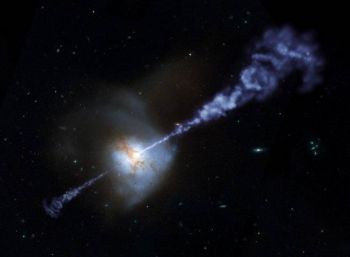Broadcast: News items
Researchers find that massive black holes halt star birth in distant galaxies
Posted on behalf of: Department of Physics and Astronomy
Last updated: Thursday, 10 May 2012

Modified image showing active black hole squashing star formation. Image: NASA/JPL-Caltech/R. Hurt
Massive black holes may exert control over the number of stars formed in the early lives of the galaxies in which they sit, astronomers working with the Herschel Space Observatory have shown in research published in the journal Nature today (10 May 2012).
Herschel data is helping to explain the link between the size of the central bulges of galaxies and the mass of their central black holes, say a team of astronomers led by Professor Seb Oliver from the University of Sussex.
All large galaxies have a massive black hole at their centre, each millions of times the mass of a single star. For over a decade scientists have been puzzled as to why the masses of the black holes are linked to the size of the round central bulges at the hearts of galaxies.
Galaxies with massive black holes were found to have high rates of star formation, with some forming stars at a thousand times the rate of our own Milky Way galaxy today. But intriguingly, the Herschel results show that the fastest-growing black holes are in galaxies with very little star formation – once the radiation coming from close to the black hole exceeds a certain power, it tends to “switch off” star formation in its galaxy.
Professor Oliver co-leads the Herschel Multi-tiered Extragalactic Survey project (HerMES), responsible for mapping large regions of the sky and discovering hundreds of thousands of galaxies using images from the SPIRE camera onboard Herschel.
Professor Oliver says: “I am delighted that the HerMES team have been able make this breakthrough on such an important topic in astrophysics. I am particularly proud of the people at Sussex who've been essential in making HerMES such a success.”
He adds: “This fantastic result provides an amazing link between black holes and star formation in the early Universe. It is a huge clue to this decade-old riddle and could mean that once a black hole is big enough and producing enough radiation, it somehow shuts down the formation of stars in the surrounding galaxy.
“The most likely explanation is that the incredibly strong winds from around these very powerful black holes are preventing the gas and dust in the rest of the galaxy from forming stars.”
To study the early lives of galaxies, astronomers need to look at very distant galaxies, so far away that we see them as they were billions of years ago.
Although the black holes themselves cannot be seen, the material closest to them can get incredibly hot, emitting large amounts of light over a very wide range of wavelengths, from radio waves to x-rays.
The light from this super-heated material can be trillions of times as bright as the Sun, with brighter emissions indicating a more massive black hole. There are also strong flows of material (winds and jets) expelled from the region around the black hole.
The hot material near the black hole outshines almost all the light from rest of the host galaxy, except for the light with wavelengths just less than a millimetre. This sub-millimetre light is invisible to normal telescopes but is seen by the Herschel Space Observatory and indicates the rate at which stars are being formed in the galaxy.

